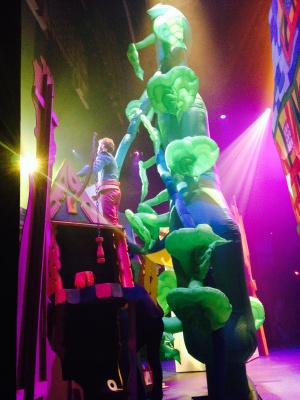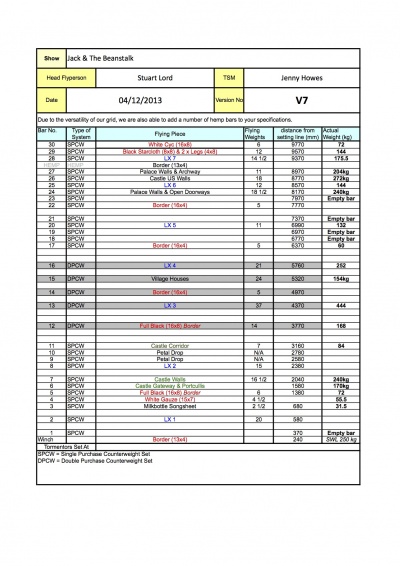Jack and the Beanstalk: Difference between revisions
| Line 151: | Line 151: | ||
===Giant's truck=== | ===Giant's truck=== | ||
The Giant's Truck was a major set element within the performance. | The Giant's Truck was a major set element within the performance. It had a large tapering floor cloth, that was attached to the front of the truck. | ||
At approximate dimensions of 2000x4500x6000mm, it was the largest piece within the production. It was designed so that it would fit through the dock doors with around 100mm clearance. This meant that 4+ crew members were required to move this piece with great care. | |||
[[File:1469814 623463774357315 478225798 n.jpg|600px]] | [[File:1469814 623463774357315 478225798 n.jpg|600px]] | ||
Revision as of 16:16, 30 January 2014
| Jack and the Beanstalk | ||||||||||||||||||||||||||
|---|---|---|---|---|---|---|---|---|---|---|---|---|---|---|---|---|---|---|---|---|---|---|---|---|---|---|
| ||||||||||||||||||||||||||
Company
Creative Team
Script Writer - Alan McHugh
Director - Alastair Hawthorn
Set & Costume Designer - Robin Peoples
Choreographer - Kerry McLellan
Musical Director - Doug Price
Lighting Designer - Oliver Gorman
Sound Designer & Operator - Sam Cunningham
Vocal Coach - Jean Sangster
Technical Team
Production Manager - Sandy McRobbie
Stage Manager- Natalie Wilson
Deputy Stage Manager - Rosie Barber
Assistant Stage Managers - Mary Crook, Chrissie Huxford
Technical Stage Manager - Jennifer Howes
Deputy Technical Stage Managers - Stuart Lord (Head Flys), Ian Smyth
Crew Supervisor - Kev Murray
Stage Crew - Riona Gilliland, Bradley Jones, Laura Mason, Kerry McAreavey, Kiri Newbery, Sean Quinn, Kirstin Rodger, Neil Smith, Daniel Thompson
Chief Production Electrician - Patrick Watson
Lighting Programmer and Operator - Elleanor Taylor
Sound No 1 - Sam Cunningham
Sound No 2 - Fraser Milroy
Video Technican - Rory Boyd
Stage Electricians - Mark Blythe, Shannon Howard
Follow Spot Ops - Stephen Cunningham, Nathalie Page
Props - April Clark, Darren Dewar, Edward Howat, Lorna Ratcliffe, Shoni Tavendale, Victoria Blackaby, Clara Fink, Zoe Kemp, Lisa Speirs
Costume - Rebecca Coyle, Helen McKnight, Nicola Russell, Ruth Walford, Carola Gudim, Evonne MacRitchie, Jade McNaughton, Sophie Prior
Construction - Connor Gallagher, Robert Gear, Lauren Keanie, Oliver Ralph
Scenic - Rosie Jacob, Carolyn Clark, Iona Gray, Gillian Reilly
Technical Stage Management
Groundplan
Flyplot
Due to the size of the LX bars, it was necessary to brail a number of the bars.
Masking
7x 12x4 soft legs
1x 8x4 soft leg (Necessitated by a missing 12x4 leg)
8 x dogleg frames. Two of these are constructed from scaff and key clamp, as we only have 6 purpose-built frames.
Pit Bridge
In previous performances which require the use of a pit bridge, there had been a number of various solutions to this problem.
For this show, it was felt that a stock platform, with stock treads should be built. This could then be customised with different height legs. This solution enabled the platform to be the same height as the auditorium, to reduce the probability of slipping or tripping.
Technical Challenges
Beanstalk

A crucial element of any production of 'Jack and the Beanstalk' is not complete without a beanstalk... This year, our beanstalk was provided by the Designer, Robin Peoples. It consisted of a fan unit, with a large section of rip-stop fabric attached to the top, forming the 'beanstalk' element.
As we were concerned about the amount of noise the fan would produce if it were to be onstage, we sited the fan unit in the pit. One of the pallets in the stage floor was removed, and replaced with a trap unit.
As the beanstalk was of fabric construction, we used a spot line attached to the top, to prevent it flapping around the stage on inflation and deflation. Although a line of hemp was used to go from the flyfloor, through the grid, fishing line was used wherever the line would be visible. This was felt to be strong, but also relatively invisible.
After tech, it was felt that the Beanstalk was too short. Therefore it was extended with a small section of green rip-stop fabric, bought from Mandors. Whilst this wasn't visible in Act 1, due to the beanstalk being hidden behind the Cludgy truck. However, in Act 2, the bottom of the beanstalk was visible due to the absence of the Cludgy. It was felt that this was an acceptable trade off.
Giant's truck
The Giant's Truck was a major set element within the performance. It had a large tapering floor cloth, that was attached to the front of the truck.
At approximate dimensions of 2000x4500x6000mm, it was the largest piece within the production. It was designed so that it would fit through the dock doors with around 100mm clearance. This meant that 4+ crew members were required to move this piece with great care.
Giant's foot
A slightly incongruous set element. This was not part of the original design, but only an idea. It was borrowed from the Lyceum in Edinburgh. Therefore, it was a very awkward set piece; one that didn't really fit the design of the show, or the size of the venue. It was used when The Giant was required to 'squash' Fleshcreep.
In the latter part of the production process, it was discovered that all the foot was required to do be slid onto the stage, and then be removed a little while later. This took 3 crew members to operate. Whilst the foot was relatively light (being made of Arex), it's large size and the placement of the booms made this process a little awkward.
Fleshcreep's Dummy
Fleshcreep's body was required to fall in a very precise space, in front of the village houses, and behind the Dairy truck. This was a gap of around 0.6m. The dummy was rigged onto the back of one of the borders (Bar 14), using a quick release shackle. A line was then taken off the shackle, and onto the Intermediate Fly Floor (due to the height of the border). This line was then used to release the shackle, and let the dummy fall.
Portcullis
This was a relatively large set element, and one that was pivotal to the plot. It was required to open and shut relatively quickly, such as your average Castle Portcullis would operate.
Confetti Drop
White confetti was used during the walk down scene. The white paper confetti that was dropped was spare that was left over from Carousel 2013.
It was dropped by using the traditional snow/confetti/petal drop bag. This was rigged onto Bars 9 and 10.
Electrics
Lighting
Video
One of the biggest challenges for electrics was creating the giant effect. It was decided by the designer this would be done by projection with a live feed of a giant (offstage in a studio). Due to budget constraints we were unable to hire a 7-10k projector to project from a downstage bar onto the set piece therefore it was decided the best method would be to mount the in-house 5k projector to the rear of the set piece, then using a combination of two mirrors bounce to the screen. This meant that even if the set piece managed to somehow move off its marks the projection would never be misaligned.
Control
For control we managed to secure a borrow Hippotizer Grasshopper media server combined with a Black Magic capture card from AC Entertainment Technologies to use as a control surface from the camera to the projector. This proved to be a valuable tool as we were able to manipulate the output to mask the overspill but also stretch the face to cover the screen.
The Studio
The studio consisted of the following items:
- Sony HD DV Camera (With BNC output)
- 2 1.2K PC's
- TV Monitor with onstage preview
- Wooden board with face cutout (to restrict movement of the actor so his face would not go out of shot)
Stage Electrician Show Cues
As panto was a very busy show the two stage electricians had several cues during the run of the show. This was mainly due to the number of trucks that needed plugged up. On the giants truck, lamps had to be re-focused during every run. Switching on the beanstalk on a cue light signal was another such cue during the run. Below is a link to one of the running lists for the show.
Sound
Equipment lists
Microphones
1x SHURE BETA 91A
2X SHURE BETA 57C
2X SEN E604
2X SHURE SM57
2X SE300
1X AUDIX D6
1X E906
2X SHURE BETA 87
3x D.I boxes
Radio kit
10X SHURE UR1BP
5X SHURE UR4D DUAL RECEIVER
10X DPA 4066 headsets
Amps
12x D6 1x D12 3x CROWN K2
Control
1x MIDAS PRO6
2x MIDAS DL251 STAGEBOX
1X MIDAS DL371 CONROL UNIT
1X Klark Teknik DN9331 Helix Rapide GEQ
1X DIGIDESIGN 003 RACK
1X MAC TOWER FOR PLAYBACK
Loudspeakers
2x D&B E12
4x D&B E8
16x D&B E0 (NO REAR fx USED)
3x D&B QSUB
2x D&B Qi7
2x D&B MAX12
3X EAW VFR129i
Band
Keys
Reed
Flute
Kit with percussion
Bass
Guitars
Sfx
For this production many classic panto style SFX were required.
Some of the more common ones were sourced from the SFX library
and others recorded by myself and Fraser Milroy.
These included:
Thunder
Lightning crack
Giant laughing – Ahd recorded
Giant roaring - Ahd recorded (several takes) must be deep and boomy.
Neighing of horses
Galloping hooves
Rife ricochet
Cow moo – recording of actress ( do several different takes, including one longer distressed moo)
Cow laughing – recording of actress
Whispering – recording of cast ( at least 2 different takes )
Plundger like pop sound (like when you pop your finger in your mouth) – recorded.
Toilet flush
Dog/puppy single yelp.
Comedy kiss sound ( 2 )
Cock(chicken) crows
Alarmed chicken cluck
Metallic clang of barbell hitting the ground
Thunderous bang of giants hand
Giant tummy rumble.
Squawking hen
Clucking hen
Loud giants foot steps
One long section of clucking that slows down to a halt
Crash of man falling into the cludgie (toilet building)
Timber cracking
Beanstalk cracking and falling to the ground
Door slam and lock.
The Giant
For the giants voice we faced the problem of having to have both live and recorded
sections. This meant that we would have to exactly replicate the FX over the vocal
for both scenarios. This was achieved by recording clean,bright voice overs which
remained mostly un-edited. I then patched the giants v/o to its own output on Qlab
and its own specific channel, separate from other sfx playback. I then routed this
to the same onboard Pitch-shifter and reverb as the Live vocal.
This ensured a flawless transition between the two voices.







